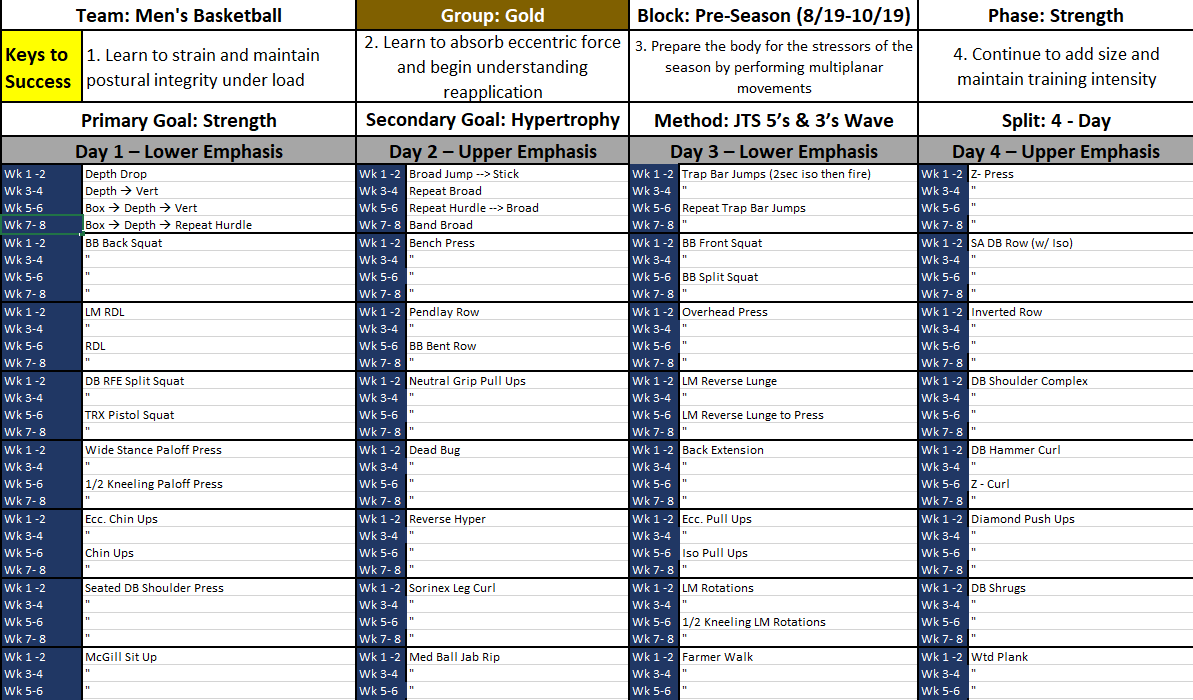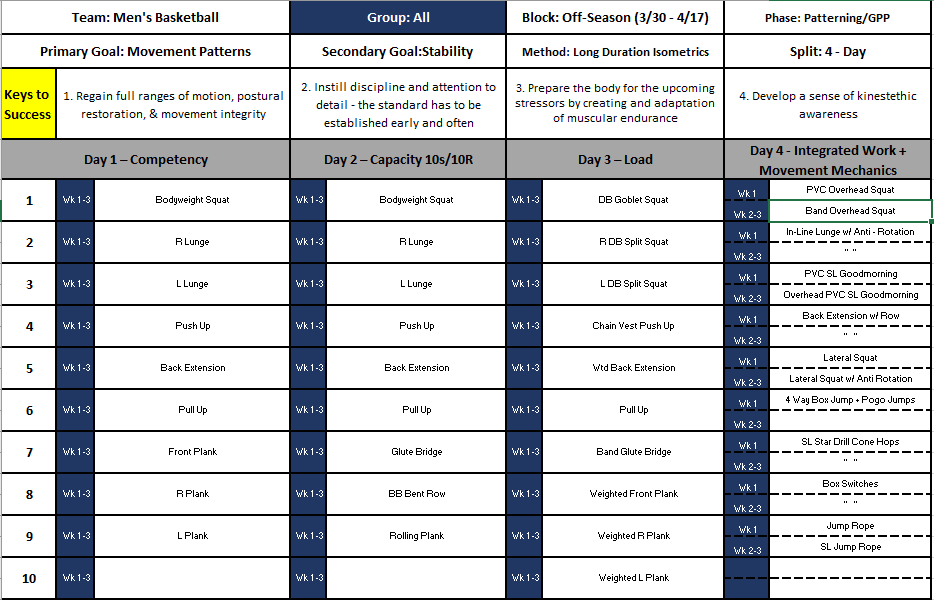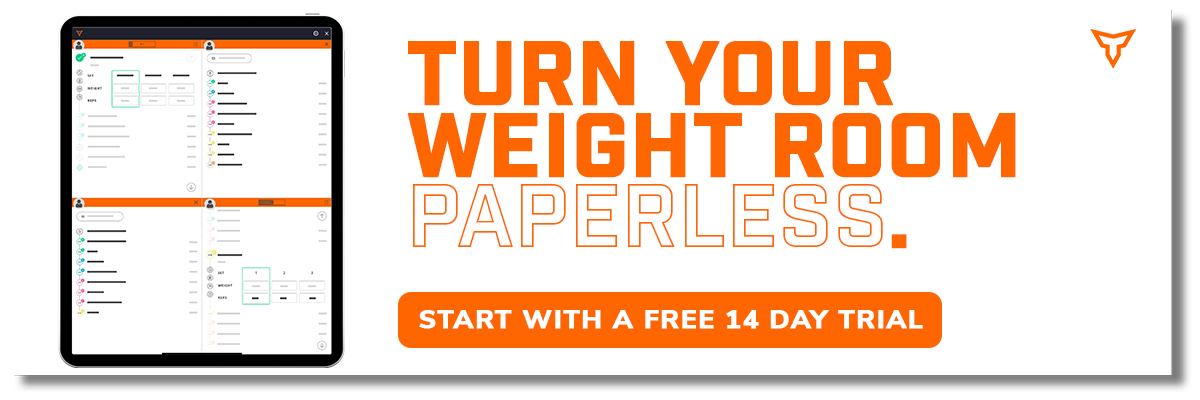Cooks Before Chefs: 4 Steps to Teaching Young Coaches to Program
If you’ve been put in charge of an intern or GA program, I can almost guarantee you can relate to the following scenario. You give one of your young coaches the responsibility of programming for the first time and their face lights up. That big grin is quickly replaced with the "deer in the headlights" look we’ve all had at one point.
We lay out our guidelines and give some pointers while they feverishly scratch notes and pretend to comprehend everything we’re saying. Eventually, you wrap up your monologue by telling them to “trust their process” or “keep it simple”. Over the next few days, that young coach spends every free minute reading programming books, scouring the internet, and picking other coaches’ brains not wanting to let you down. Finally, the moment of truth comes and they bring you their first draft. You look it over, make some suggestions, and they return to burning the midnight oil. This review and revision process goes back and forth a few times, and eventually, you sign off on the program.
Now, if you’re like me, you know the program is far from perfect and there are some things that will serve as learning opportunities, but you let the young coach find that out on their own.
The first training block goes well. The young coach executes the program and notices the things you were hoping they would correct. Then the time comes for the next training block and you ask if they have any questions. Armed with their freshly earned confidence from the first phase, they respond with “I think I got this”. You trust them and show up to watch their training session. BOOM! You see progressions and movement pairings that leave you scratching your head. How did this happen? Well, let’s be honest. Most young coaches haven’t programmed beyond a single training block. Even in some of the best internship programs, their programming projects rarely cover more than 8 weeks. They have yet to be put in the position to reverse engineer an entire training year.
I’ve been lucky in my career to have had the opportunity to both be mentored by great coaches and mentor some phenomenal young coaches. As I made the transition from intern to assistant and eventually to a director, I did what many coaches do and developed my own process for programming.
Somewhere along the journey (hopefully sooner rather than later) we all ditch the instruction manual and develop a process that works for us. This can mean things get lost in translation as we try to teach our young staff members to program on their own. Often times, this means GA’s or interns are faced with 2 choices: replicate how you program or fend for themselves.
It’s always been my opinion that the best program is the one you can coach the best. For young coaches, that usually means keeping it simple and sticking to what they know. I have no problem with this approach and I tell all my young staff members “you have to learn to cook before you can be a chef”. Usually this is met with a blank stare or a nervous laugh. I always explain it this way; when you first start cooking, you follow the recipe as it’s written with the exception of one line…salt to taste. This simple freedom allows you to start tweaking the recipe and making it your own without losing the primary objective. Over time, you grow more confident in flavor pairings and seasonings, until eventually you come up with your rendition of “Grandma’s gumbo”. This process doesn’t happen overnight. Before you can veer off the beaten path, you have to follow the instructions. Programming is no different.
To help my young coaches gain confidence in their programming skills, I have developed the following system. Yes, it’s basic. Yes, it’s tedious. Yes, it’s repetitive. However, it allows them freedom with guard rails to keep them on track. I’m not claiming to have the best system in the world, but it’s worked for our young coaches and has developed into an easily repeated model for teaching programming to new staff members without requiring them to be clones.
Each step must be completed and reviewed with me prior to moving on to the next step.
Step 1: Sport Needs Analysis
During this step, I expect staff members to familiarize themselves with the demands of the sport. Usually, young coaches have limited experiences with different sports and may not have any knowledge of the game. When I first started coaching, I had never watched a full field hockey game and had no idea what the actual demands of the sport were. I spent time on YouTube and Google watching full games and skill videos to familiarize myself with the game. I also spent time at practice to confirm what I was getting from the online resources was applicable to the game. To streamline this step for young coaches I require them to list the following:
- Key Performance Indicators for Sport
- Key muscle actions
- Primary energy system
- Proposed testing battery
Step 2: Team Needs Analysis
This is the time when I expect young coaches to meet with their sport coaches and discuss current roster/team needs. What we believe the team needs and what the coach believes they need may be two different things. This allows them to also get a feel for any programming restrictions/suggestions as well as expectations. As we all know, there are some sport coaches that feel strongly about certain movements/approaches and, at times, these can influence our programming decisions. It’s also a good opportunity for them to defend their thought process on the testing battery while the data is fresh in their minds because, after all, you can have your own opinion but not your own science.
The second element of this step involves meeting with sports medicine and getting injury reports on the team. Beyond current injuries, I expect young coaches to consult sport med to talk about reoccurring injuries, common problem areas, etc. This meeting serves two purposes:
- Provides more context for the needs of the training
- Builds relationship and hopefully an ally in sports medicine
Step 3: The Annual Plan
I know Coach Matrixx just wrote an obituary for the annual plan, but I still like to utilize it as a framework. For young coaches, it provides structure to their programming and can guide progressions. If they know they need to get to point C by XYZ date, it’s easier to know how long they can spend on A and B. For older coaches, we can rely more heavily on the coaches’ eye and our experience. Young coaches don’t have those experiences to call upon, and giving them the answers is doing them a disservice. Let them use the annual plan to stay organized until they’ve built the experiences necessary to take off the training wheels.
I provide my staff with my own annual plan template as well as a few others I’ve gathered over the years. I usually start by showing them the original template I used and what it looks like now. Going back to our chef example, I tell them to “salt to taste” and tweak the template as necessary. I make sure my initial template includes the fundamentals to provide a framework for their programming such as calendars, training emphasis, etc.
Here’s an example of the template I provide:

Note about annual plans: Even if they’re taking over a team mid-semester, I make them go back and start at the beginning so I’m sure they understand the big picture.
Step 4: Phase Breakdown
This step is an additional guardrail I built into my own programming process over the years. I have no problem admitting it is a direct result of my tendency to tinker and tweak within phases. I would spend hours programming what I believed was the perfect program, then inevitably I’d make changes too early and too often.
Early in my career there were times my training would look completely different than the original plan. This isn’t always a bad thing, as changes are necessary and we all know our profession is filled with curveballs. Excessive tweaking and changing or change for the sake of change can and will damage training outcomes. Instead, I learned to trust myself and use the phase breakdown template as a way to reaffirm my thought process. In short, I knew I had a reason for programming the way I did, but sometimes a reminder is necessary. The phase breakdown has a few key components that help young coaches to stay on track:
- Keys to Success – this section allows you to identify 3-4 key objectives for this training block. Come hell or high water, if I get these things done, the block is a success. Having these in front of you while programming helps you to keep the main thing the main thing without getting lost in every obscure detail.
- Primary and Secondary Goals – By clearly defining the desired stimulus the programming and exercise selection become much less daunting of a task for young coaches.
- Exercise progressions – Young coaches may not have a grasp on why/how to progress exercises in an organized fashion. Filling in this section allows them to look at their entire progression and ensure it makes sense. It also serves as a guardrail by highlighting novelty for the sake of novelty. There’s no hiding when it’s right in front of you.
Here are 2 examples of phase breakdowns:


Once these steps are complete, I suggest young coaches revisit them often as they are planning and programming each phase. As they become more confident and proficient, I may allow them to add or remove steps as appropriate. Ultimately, I want to create a system where they are free to make mistakes without becoming reckless or dangerous. The 4-step process forces them to really think through their programming and look ahead as opposed to just attacking this week. My hope is that they develop their own system and learn to deviate from the beaten path without losing the principles that make successful training programs successful. Our goal as mentors should be to prepare our young coaches to be chefs, not line cooks.
Subscribe to our blog
Subscribe to receive the latest blog posts to your inbox every week.
Related posts

How TeamBuildr Became a MLB Coaching Software for Strength Coaches

Will Artificial Intelligence Take Over Strength Coach Jobs?


